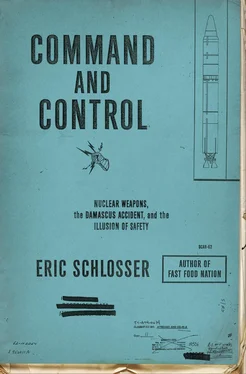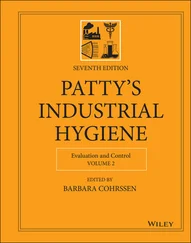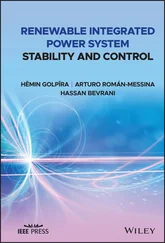By six o’clock in the evening, the platforms had finally been repaired, and the PTS team was ready to do its work. Childers was in the control center, instructing the trainee. Mazzaro and Heineman, the PTS team chief, were there as well, going over the checklist for the procedure. Holder decided to get a few hours of sleep. Although the control center was underground and far removed from the world, it was always noisy. Motors, fans, and pumps were constantly switching on and off. Test messages from SAC were loudly broadcast over the speakers, and telephones rang. The sound had nowhere to go, so it bounced off the walls. Holder never slept well there, even with earplugs. The vibration bothered him more than the noise. The whole place was mounted on springs, and there was so much machinery running that the walls and the floors always seemed to be vibrating. It was the sort of thing you didn’t notice, until you became perfectly still, and then it became hard to ignore.
Holder took off his socks and shoes, put on a T-shirt and some pants from an old uniform, and had a bite to eat before bed. He was washing dishes when the Klaxon went off. The sound was excruciatingly loud, like a fire alarm, an electric buzzer inside your head. He didn’t think much of it. Whenever a nitrogen line was connected to an oxidizer tank, a little bit of vapor escaped. The vapor detectors in the silo were extremely sensitive, and they’d set off the Klaxon. It happened almost every time a PTS team did this procedure. The launch crew would reset the alarm, and the Klaxon would stop. It was no big deal. Holder kept doing the dishes, the Klaxon stopped — and then ten or fifteen seconds later it started blaring again.
“Dang,” Holder thought, “why’d that go off again?” He heard people scurrying on the level below and wondered what was going on. He went halfway down the stairs, looked at the commander’s console, and saw all sorts of lights flashing. He thought the PTS team must have spiked the MSA — the vapor detector manufactured by the Mine Safety Appliances Company. If the MSA became saturated with too much vapor, it spiked, going haywire and setting off numerous alarms. That didn’t mean anything was wrong. But it did mean one more hassle. Now the crew would have to conduct a formal investigation with portable vapor detectors.
Holder went back upstairs and grabbed his boots. When he came down again, Captain Mazzaro was standing and talking on the phone to the command post in Little Rock. Childers was giving orders to the PTS team topside. Something wasn’t right. Holder sat at the commander’s console and looked down at rows of red warning lights. OXI VAPOR LAUNCH DUCT was lit. FUEL VAPOR LAUNCH DUCT was lit. VAPOR SILO EQUIP AREA, VAPOR OXI PUMP ROOM, and VAPOR FUEL PUMP ROOM were lit. He’d seen those before, when an MSA spiked. But he’d never seen two other lights flashing red: FIRE FUEL PUMP ROOM and FIRE LAUNCH DUCT. Those were serious. There’s a problem, Holder thought. And it could be a big one.
In the old black-and-white photograph, a young man stands at the bedroom door of a modest home. He wears khakis and a white T-shirt, carries a small metal box, and doesn’t smile for the camera. He could be a carpenter arriving for work, with his lunch or his tools in the box. A cowboy hat hangs on the wall, and a message has been scrawled on the door in white chalk: “PLEASE USE OTHER DOOR — KEEP THIS ROOM CLEAN.” The photo was taken on the evening of July 12, 1945, at the McDonald Ranch House near Carrizozo, New Mexico. Sergeant Herbert M. Lehr had just arrived with the unassembled plutonium core of the world’s first nuclear device. The house belonged to a local rancher, George McDonald, until the Army obtained it in 1942, along with about fifty thousand acres of land, and created the Alamogordo Bombing and Gunnery Range. The plutonium core spent the night at the house, guarded by security officers. A team of physicists from the Manhattan Project was due at nine o’clock the next morning, Friday the thirteenth. After billions of federal dollars spent on this top secret project, after the recruitment of Nobel laureates and many of the world’s greatest scientific minds, after revolutionary discoveries in particle physics, chemistry, and metallurgy, after the construction of laboratories and reactors and processing facilities, employing tens of thousands of workers, and all of that accomplished within three years, the most important part of the most expensive weapon ever built was going to be put together in the master bedroom of a little adobe ranch house. The core of the first nuclear device would be not only home made but hand made. The day before, Sergeant Lehr had sealed the windows with plastic sheets and masking tape to keep out the dust.
Although the question of how to control an atomic bomb had inspired a good deal of thought, a different issue now seemed more urgent: Would the thing work? Before leaving Los Alamos, two hundred miles to the north, some of the Manhattan Project’s physicists had placed bets on the outcome of the upcoming test, code-named Trinity. Norman F. Ramsey bet the device would be a dud. J. Robert Oppenheimer, the project’s scientific director, predicted a yield equal to 300 tons of TNT; Edward Teller thought the yield would be closer to 45,000 tons. In the early days of the project, Teller was concerned that the intense heat of a nuclear explosion would set fire to the atmosphere and kill every living thing on earth. A year’s worth of calculations suggested that was unlikely, and the physicist Hans Bethe dismissed the idea, arguing that heat from the explosion would rapidly dissipate in the air, not ignite it. But nobody could be sure. During the drive down from Los Alamos on Friday the thirteenth, Enrico Fermi, who’d already won a Nobel for his discoveries in physics, suggested that the odds of the atmosphere’s catching fire were about one in ten. Victor Weisskopf couldn’t tell if Fermi was joking. Weisskopf had done some of the calculations with Teller and still worried about the risk.
As Louis Slotin prepared to assemble the plutonium core, the safety precautions were as rudimentary as the work space. Jeeps waited outside the house, with their engines running, in case everyone had to get out of there fast. Slotin was a Canadian physicist in his early thirties. For the past two years at Los Alamos he’d performed some of the most dangerous work, criticality experiments in which radioactive materials were brought to the verge of a chain reaction. The experiments were nicknamed “tickling the dragon’s tail,” and a small mistake could produce a lethal dose of radioactivity. At the ranch house, Slotin placed a neutron initiator, which was about the size of a golf ball, into one of the plutonium hemispheres, attached it with Scotch tape, put the other hemisphere on top, and sealed a hole with a plutonium plug. The assembled core was about the size of a tennis ball but weighed as much as a bowling ball. Before handing it to Brigadier General Thomas F. Farrell, Slotin asked for a receipt. The Manhattan Project was an unusual mix of civilian and military personnel, and this was the nation’s first official transfer of nuclear custody. The general decided that if he had to sign for it, he should get a chance to hold it. “So I took this heavy ball in my hand and I felt it growing warm,” Farrell recalled. “I got a sense of its hidden power.”
The idea of an “atomic bomb,” like so many other technological innovations, had first been proposed by the science fiction writer H. G. Wells. In his 1914 novel The World Set Free , Wells describes the “ultimate explosive,” fueled by radioactivity. It enables a single person to “carry about in a handbag an amount of latent energy sufficient to wreck half a city.” These atomic bombs threaten the survival of mankind, as every nation seeks to obtain them — and use them before being attacked. Millions die, the world’s great capitals are destroyed, and civilization nears collapse. But the novel ends on an optimistic note, as fear of a nuclear apocalypse leads to the establishment of world government. “The catastrophe of the atomic bombs which shook men out of cities… shook them also out of their old established habits of thought,” Wells wrote, full of hope, on the eve of the First World War.
Читать дальше












